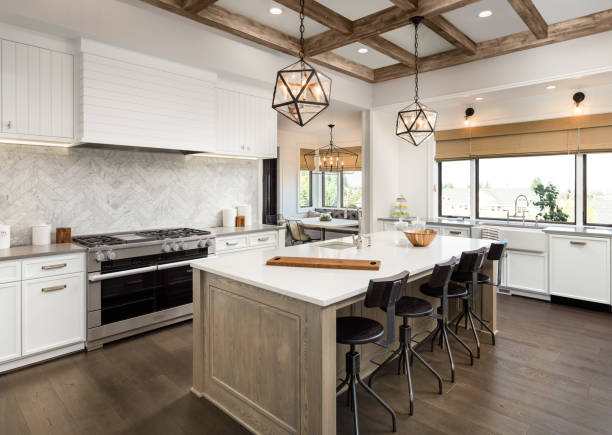kitchen pendant lights

Kitchen pendant lights are an essential element of modern kitchen design, combining functionality with aesthetic appeal. These hanging fixtures not only provide practical illumination for various kitchen tasks but also serve as stylish focal points that enhance the overall look and feel of the space. In this comprehensive exploration, we will delve into the diverse aspects of kitchen pendant lights, from their design and placement to their impact on ambiance and functionality.
Design Diversity:
One of the most striking features of kitchen pendant lights is their wide-ranging design diversity. Pendant lights come in an array of styles, shapes, and materials, allowing homeowners to choose fixtures that complement their kitchen’s design theme. Whether you prefer the sleek and minimalistic look of contemporary pendant lights or the vintage charm of industrial-style fixtures, the market offers an abundance of options to suit every taste and kitchen decor.
Materials Matter:
Pendant lights can be crafted from various materials, each contributing to a distinct visual and tactile experience. Common materials include glass, metal, wood, and even fabric. Glass pendants, for instance, can add a touch of elegance and transparency, creating a sense of openness in the kitchen. Metal pendants, on the other hand, may exude an industrial or rustic vibe, depending on the finish. Wooden pendant lights introduce warmth and a natural feel, while fabric shades soften the light and add a touch of softness to the overall atmosphere.
Placement Precision:
Proper placement of pendant lights is crucial for achieving both functional and aesthetic goals. Over the kitchen island is a popular location for pendant lights, providing focused illumination for meal preparation and adding a visually appealing element to the central workspace. Ensuring the lights are hung at an appropriate height is essential; too low, and they may obstruct the view or be a hazard; too high, and they might not effectively light up the intended area. Striking the right balance between functionality and aesthetics is key to achieving the desired outcome.
Ambiance Amplified:
Beyond their practical function, pendant lights play a pivotal role in shaping the ambiance of the kitchen. The type of light bulb used can influence the mood significantly. Warm-toned bulbs create a cozy and inviting atmosphere, ideal for intimate gatherings and relaxed family meals. On the other hand, cool-toned bulbs may enhance a modern and crisp aesthetic, perfect for contemporary kitchen designs. Dimmable options provide flexibility, allowing homeowners to adjust the lighting according to different activities and occasions.
Task Lighting Brilliance:
In the kitchen, where precision is essential, pendant lights serve as excellent task lighting fixtures. When strategically placed, they can illuminate specific areas, such as the countertop or stove, providing ample light for chopping, cooking, and other kitchen chores. Pendant lights with adjustable features allow for targeted lighting, ensuring that tasks are performed with precision while maintaining an elegant and cohesive design.
Size Matters:
Selecting the right size of pendant lights is crucial for achieving a harmonious look. Too small, and they may get lost in the space; too large, and they might overwhelm the kitchen visually. The size of the pendant lights should be proportional to the size of the kitchen and the designated area they are meant to illuminate. Consideration of ceiling height is also important; high ceilings may accommodate larger and more dramatic pendant fixtures.
Installation Ingenuity:
The installation of kitchen pendant lights demands careful consideration of electrical wiring and support structures. Professional installation is recommended to ensure safety and functionality. Pendant lights can be installed as a single unit or in groups, depending on the kitchen layout and design preferences. Clustered pendants, for instance, can create a captivating focal point, while a row of evenly-spaced pendants imparts a sense of symmetry.
Energy Efficiency:
As the world becomes increasingly focused on sustainability, energy-efficient lighting options are gaining popularity. LED pendant lights, in particular, offer an eco-friendly and cost-effective solution. Not only do they consume less energy, but they also have a longer lifespan, reducing the need for frequent replacements. Homeowners can make a positive environmental impact by choosing energy-efficient pendant lights without compromising on style or functionality.
Maintenance and Cleaning:
Keeping pendant lights clean is essential for maintaining their visual appeal and maximizing light output. Depending on the material and design, cleaning methods may vary. Glass pendant lights can be wiped down with a glass cleaner. At the same time, metal fixtures may require a gentle cleaning solution to prevent corrosion. Regular maintenance ensures that the kitchen pendant lights continue to shine brightly and contribute to the overall aesthetic of the space.
Conclusion:
In conclusion, kitchen pendant lights are not just useful fixtures; they are integral elements that contribute to the overall design, functionality, and ambiance of the kitchen. From their diverse designs and materials to strategic placement and energy efficiency, every aspect plays a role in creating a visually stunning and highly functional kitchen space. As homeowners continue to prioritize both style and substance, the evolution of kitchen pendant lights is likely to bring forth even more innovative and aesthetically pleasing options for the heart of the home.




Leave a Reply